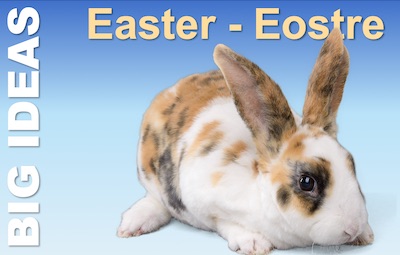
 If you grew up in a Christian country and you don’t know the Easter story… Well, you weren’t paying attention in primary school.
If you grew up in a Christian country and you don’t know the Easter story… Well, you weren’t paying attention in primary school.
So, in this article, we are going to look back, beyond the Christian era, to the origins of Easter… Eostre.
And, along the way, we’ll learn what it symbolises and why it’s still a Big Idea for managers and business people.
Why is Easter a Big Idea for Managers?
Put simply, it’s down to a brilliant manager: Pope Gregory I. He managed Papal affairs with great effectiveness but it was one insight I want to focus on. In sending a mission to the heathen wilds of Britain, Gregory briefed them in a way that truly understood what we would now call ‘stakeholder engagement’.
His plan was to introduce Christianity to a pagan culture with its own deeply-rooted religious beliefs and practices. And the way he instructed his missionaries to do this was to encourage the locals to maintain their existing festivals and customs, but to overlay elements of Christian ceremony, symbolism, and belief onto them.
In this blog, we’ve already talked about the pre-Christian winter festival onto which Christmas was superimposed. But Christmas already contained elements of Mithraism. Now, the Christian observance of the death and resurrection of Jesus, with its deep roots in the Jewish Passover festival (Pesach in Hebrew – and hence the Christian adjective Paschal for Easter. Pâques is the French name for Easter) was going to meet the Northern European celebration of spring and the dawn.
What is Eostre – the prototype for Easter?
I’m not going to go into the detailed etymology of the words Easter, Eostre, and East. Nor can we say much about the ancient Northern European deity associated with spring, rebirth, and the dawn. The first is complex and confused. the second is lost to us because it really only existed in a time and place where written records either never existed or failed to survive.
But, suffice to say that by the time Gregory’s mission-led by Augustine (who’d become the first Archbishop of Canterbury) arrived in England, there was already a Spring festival. Its name is lost, but the month was called Ēosturmōnaþ, which means Eostre’s month. It took its name from a Germanic goddess, whom we’ll call Eostre. But there are plenty of alternative spellings in dialects from all over Northern Europe and the regional kingdoms of Anglo Saxon England. The Germanic name is often rendered as Ostara.
Ostara or Eostre symbolised the dawn – which of course rises in the East. That’s why the two are cognate forms. And the many towns in England that appear to take their name from Eostre or Easter are all on the East of the country.
Celebration of Eostre
By the time of Gregory and Augustine, the Germanic Angles and Saxons had been in England for a fair while. And it seems that they saw Eostre as a goddess of Spring and of Rebirth. But we don’t know much about her, because mention of her in literature and artifacts is scant.
The Anglo Saxons seem to have celebrated Eostre as the agency for the countryside coming back to life after Winter. New-born animals were plentiful, which probably accounts for her sacred animal being the hare. (Rabbits were likely still rare, having been introduced by the Romans – hares were indigenous and likely more common when the Anglo Saxons arrived). Her other sacred symbol was probably the egg – not a hard association to fathom.
Taking over the Eostre Symbolism for Easter
Just as Jesus is reborn in Christian Easter Symbolism, so Eostre stands for rebirth. So, reinventing Eostre as a Christian festival was easy for the early missionaries. The crossover goes beyond the Rebirth – Reincarnation link. There is also the association between Dawn and the idea of the Light of the world.
What the early Christian church understood well was the nature of change and how to make it work, in a potentially adverse political climate. Imposing something new and radically different will create resistance and opposition. But, if you allow people to keep doing what they do, there will be no resistance. Now join in, and do what they do. But add a little of your own flavour to it and they may accept that. Some new ritual and differing interpretations.
Take elements from the ideas and philosophies of the old. Highlight the overlaps with the philosophies of the new. And, over time, gently shift the emphasis from the old ways to the new ones. And what do you end up with?
Murphy’s Pickaxe
The worker, Murphy, has had his pickaxe for 40 years. It’s had four new handles and is on its second head. But it’s still the same pickaxe to him.
Easter has a new deity, new observances, and a new underlying theology. But it’s the same spring equinox festival of rebirth and renewal.
That’s how to reinvent and make change happen.
And that’s why Pope Gregory deserves a place as a great management thinker!
What is Your experience of Easter?
and What is Your Experience of Reinvention and Subtle Change-craft?
We’d love to hear your experiences, ideas, and questions. Please leave them in the comments below.
To learn more…
The Managing Change Pocketbook offers a concise description of the change process, its problems, and the solutions.
